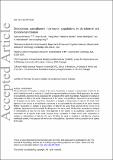| dc.contributor.author | Monteiro, Patricia | |
| dc.contributor.author | Barak, Boaz | |
| dc.contributor.author | Zhou, Yang | |
| dc.contributor.author | McRae, Rebecca | |
| dc.contributor.author | Rodrigues, Diana | |
| dc.contributor.author | Wickersham, Ian R. | |
| dc.contributor.author | Feng, Guoping | |
| dc.date.accessioned | 2020-07-28T22:40:01Z | |
| dc.date.available | 2020-07-28T22:40:01Z | |
| dc.date.issued | 2018-05 | |
| dc.date.submitted | 2018-01 | |
| dc.identifier.issn | 0022-3751 | |
| dc.identifier.uri | https://hdl.handle.net/1721.1/126428 | |
| dc.description.abstract | Key points: There are two electrophysiological dichotomous populations of parvalbumin (PV) interneurons located in the dorsal striatum. Striatal PV interneurons in medial and lateral regions differ significantly in their intrinsic excitability. Parvalbumin interneurons in the dorsomedial striatum, but not in the dorsolateral striatum, receive afferent glutamatergic input from cingulate cortex. Abstract: Dorsomedial striatum circuitry is involved in goal-directed actions or movements that become habits upon repetition, as encoded by the dorsolateral striatum. An inability to shift from habits can compromise action-control and prevent behavioural adaptation. Although these regions appear to be clearly behaviourally distinct, little is known about their distinct physiology. Parvalbumin (PV) interneurons are a major source of striatal inhibition and are usually considered as a homogeneous population in the entire dorsal striatum. In the present study, we recorded PV interneurons in dorsal striatum slices from wild-type male mice and suggest the existence of two electrophysiological dichotomous populations. We found that PV interneurons located at the dorsomedial striatum region have increased intrinsic excitability compared to PV interneurons in dorsolateral region. We also found that PV interneurons in the dorsomedial region, but not in the dorsolateral striatum region, receive short-latency excitatory inputs from cingulate cortex. Therefore, the results of the present study demonstrate the importance of considering region specific parvalbumin interneuron populations when studying dorsal striatal function. | en_US |
| dc.language.iso | en | |
| dc.publisher | Wiley | en_US |
| dc.relation.isversionof | http://dx.doi.org/10.1113/jp275936 | en_US |
| dc.rights | Creative Commons Attribution-Noncommercial-Share Alike | en_US |
| dc.rights.uri | http://creativecommons.org/licenses/by-nc-sa/4.0/ | en_US |
| dc.source | Other repository | en_US |
| dc.title | Dichotomous parvalbumin interneuron populations in dorsolateral and dorsomedial striatum | en_US |
| dc.title.alternative | Parvalbumin interneurons in dorsal striatum | en_US |
| dc.type | Article | en_US |
| dc.identifier.citation | Monteiro, Patricia et al. "Dichotomous parvalbumin interneuron populations in dorsolateral and dorsomedial striatum." Journal of Physiology (August 2018): 3695-3707 © 2018 The Authors and The Physiological Society | en_US |
| dc.contributor.department | McGovern Institute for Brain Research at MIT | en_US |
| dc.contributor.department | Massachusetts Institute of Technology. Department of Brain and Cognitive Sciences | en_US |
| dc.relation.journal | Journal of Physiology | en_US |
| dc.eprint.version | Author's final manuscript | en_US |
| dc.type.uri | http://purl.org/eprint/type/JournalArticle | en_US |
| eprint.status | http://purl.org/eprint/status/PeerReviewed | en_US |
| dc.date.updated | 2019-10-01T12:18:35Z | |
| dspace.date.submission | 2019-10-01T12:18:37Z | |
| mit.journal.volume | 596 | en_US |
| mit.journal.issue | 16 | en_US |
| mit.metadata.status | Complete | |
